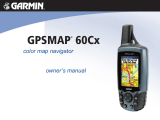
Table of Contents
Getting Started............................................................... 1
Device Overview......................................................................... 1
Keys............................................................................................ 1
Battery Information..................................................................... 1
Installing AA Batteries............................................................ 1
Turning On the Device................................................................ 1
Profiles............................................................................ 1
Selecting a Profile....................................................................... 1
Creating a Custom Profile...........................................................1
Changing a Profile Name............................................................1
Deleting a Profile........................................................................ 1
Waypoints, Routes, and Tracks.................................... 2
Waypoints................................................................................... 2
Creating a Waypoint.............................................................. 2
Projecting a Waypoint............................................................ 2
Navigating to a Waypoint....................................................... 2
Editing a Waypoint................................................................. 2
Deleting a Waypoint............................................................... 2
Waypoint Averaging............................................................... 2
Routes........................................................................................ 2
Creating a Route.................................................................... 2
Editing the Name of a Route.................................................. 2
Editing a Route...................................................................... 2
Viewing a Route on the Map.................................................. 2
Deleting a Route.................................................................... 2
Navigating a Saved Route..................................................... 2
Stopping Navigation............................................................... 2
Reversing a Route................................................................. 2
Tracks......................................................................................... 2
Tracks Settings...................................................................... 3
Viewing the Current Track..................................................... 3
Saving the Current Track....................................................... 3
Clearing the Current Track.....................................................3
Deleting a Track..................................................................... 3
Navigating a Saved Track...................................................... 3
Using the Main Pages.................................................... 3
Map............................................................................................. 3
Navigating with the Map.........................................................3
Changing the Map Orientation............................................... 3
Measuring Distance on the Map............................................ 3
Map Settings.......................................................................... 3
Compass.....................................................................................3
Navigating with the Compass................................................ 3
Course Pointer....................................................................... 3
Data Fields............................................................................. 3
Highway Mode............................................................................ 4
Sail Racing..................................................................................4
Setting the Starting Line.........................................................4
Instruments................................................................................. 4
Instrument Setup Options...................................................... 4
Changing the Data Fields........................................................... 4
Data Fields............................................................................. 4
Restoring Default Page Settings................................................ 5
Tack Assist................................................................................. 5
Configuring Tack Assist Settings........................................... 5
Speed History............................................................................. 5
Configuring the Speed History............................................... 5
Main Menu Features and Settings................................ 5
Satellite Page..............................................................................5
Satellite Settings.................................................................... 5
Additional Main Menu Tools....................................................... 5
Calculating the Size of an Area............................................. 6
Geocaches............................................................................. 6
Customizing Your Device.............................................. 6
Customizing the Data Fields....................................................... 6
System Settings.......................................................................... 6
Serial Interface Settings......................................................... 6
Display Settings.......................................................................... 6
Setting the Device Tones............................................................6
Setting Up Marine Alarms........................................................... 6
Marine Settings...................................................................... 6
Resetting Data............................................................................ 6
Changing the Page Sequence.................................................... 6
Adding a Page....................................................................... 6
Removing a Page from the Page Sequence......................... 6
Changing the Units of Measure.................................................. 7
Time Settings.............................................................................. 7
Position Format Settings.............................................................7
Routing Settings......................................................................... 7
Device Information......................................................... 7
Specifications..............................................................................7
Appendix......................................................................... 7
Registering Your Device............................................................. 7
Support and Updates.................................................................. 7
Setting Up Garmin Express................................................... 7
Viewing Device Information........................................................ 7
Contacting Garmin Product Support........................................... 7
Sharing Data with HomePort™...................................................7
Adjusting the Backlight and Contrast.......................................... 7
Maximizing Battery Life...............................................................7
Long-Term Storage................................................................ 7
Turning off GLONASS........................................................... 7
Adjusting the Backlight and Contrast..................................... 7
Adjusting the Backlight Timeout.............................................8
Data Management...................................................................... 8
File Types.............................................................................. 8
Connecting the Device to Your Computer............................. 8
Transferring Files to Your Device.......................................... 8
Deleting Files......................................................................... 8
Disconnecting the USB Cable................................................8
Attaching the Wrist Strap............................................................ 8
Device Care................................................................................ 8
Cleaning the Device............................................................... 8
Troubleshooting.......................................................................... 8
Resetting the Device.............................................................. 8
Restoring All Default Settings................................................ 8
Index................................................................................ 9
Table of Contents i
















